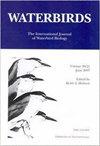Responses of Imperiled Snowy Plovers (Charadrius nivosus) to Anthropogenic and Natural Disturbance in the Florida Panhandle
IF 0.6
4区 生物学
Q3 ORNITHOLOGY
引用次数: 0
Abstract
Abstract. The habitat of beach-nesting birds often overlaps with areas heavily used for human recreation. Human activity has been linked to negative behavioral and reproductive consequences for shorebirds; therefore, it is important for managers to understand how to best mitigate disturbance. In Florida, there is concern that human disturbance negatively affects the state-threatened population of Snowy Plovers (Charadrius nivosus). We measured response probabilities and flight initiation distances (FIDs) of Snowy Plovers at sites experiencing a range of human use. Snowy Plovers responded at longer distances to pedestrians and dogs than to competitor and predator species, except for incubating birds which responded at longer distances to predators. At all distances below 50 m, plovers had a response probability of > 0.2 for pedestrians. Dogs induced such strong reactions at close distances that plovers always displaced before they came within 20 m. Brood-rearing plovers were more sensitive to anthropogenic disturbance than plovers engaged in other behaviors. Plovers at sites with high disturbance generally had lower FIDs than birds at sites with less disturbance. Our findings illustrate the importance of accounting for differences in disturbance regimes among sites when setting buffer distances, and for protecting brood-rearing areas in addition to nesting habitat. Due to the severity of responses prompted by dogs, managers should strongly consider dog prohibitions at sites with breeding Snowy Plovers, as reasonable buffers may not be adequate.佛罗里达狭长地带濒危雪鸻对人为和自然干扰的响应
摘要在海滩筑巢的鸟类的栖息地经常与大量用于人类娱乐的地区重叠。人类活动与滨鸟的负面行为和繁殖后果有关;因此,对于管理者来说,了解如何最好地减轻干扰是很重要的。在佛罗里达州,人们担心人类的干扰会对受到该州威胁的雪鸻(Charadrius nivosus)种群产生负面影响。我们测量了雪鸻的反应概率和飞行起始距离(FIDs)在经历一系列人类使用的地点。雪鸻对行人和狗的反应距离比对竞争对手和捕食者的反应距离要远,除了孵化中的鸟类对捕食者的反应距离更远。在所有距离小于50 m的情况下,探测车对行人的响应概率> 0.2。狗在近距离引起了强烈的反应,以至于鸻总是在20米之内就离开了。育雏鸻对人为干扰的敏感性高于从事其他行为的鸻。干扰程度高的地点的鸻的FIDs普遍低于干扰程度低的地点的鸟类。我们的研究结果说明了在设置缓冲距离时考虑不同地点干扰制度差异的重要性,以及保护产卵区和筑巢栖息地的重要性。由于狗引起的严重反应,管理人员应强烈考虑在繁殖雪鸻的地点禁止狗,因为合理的缓冲可能不够。
本文章由计算机程序翻译,如有差异,请以英文原文为准。
求助全文
约1分钟内获得全文
求助全文
来源期刊

Waterbirds
生物-鸟类学
CiteScore
1.30
自引率
0.00%
发文量
0
审稿时长
6-12 weeks
期刊介绍:
Waterbirds is an international scientific journal of the Waterbird Society. The journal is published four times a year (March, June, September and December) and specializes in the biology, abundance, ecology, management and conservation of all waterbird species living in marine, estuarine and freshwater habitats. Waterbirds welcomes submission of scientific articles and notes containing the results of original studies worldwide, unsolicited critical commentary and reviews of appropriate topics.
 求助内容:
求助内容: 应助结果提醒方式:
应助结果提醒方式:


